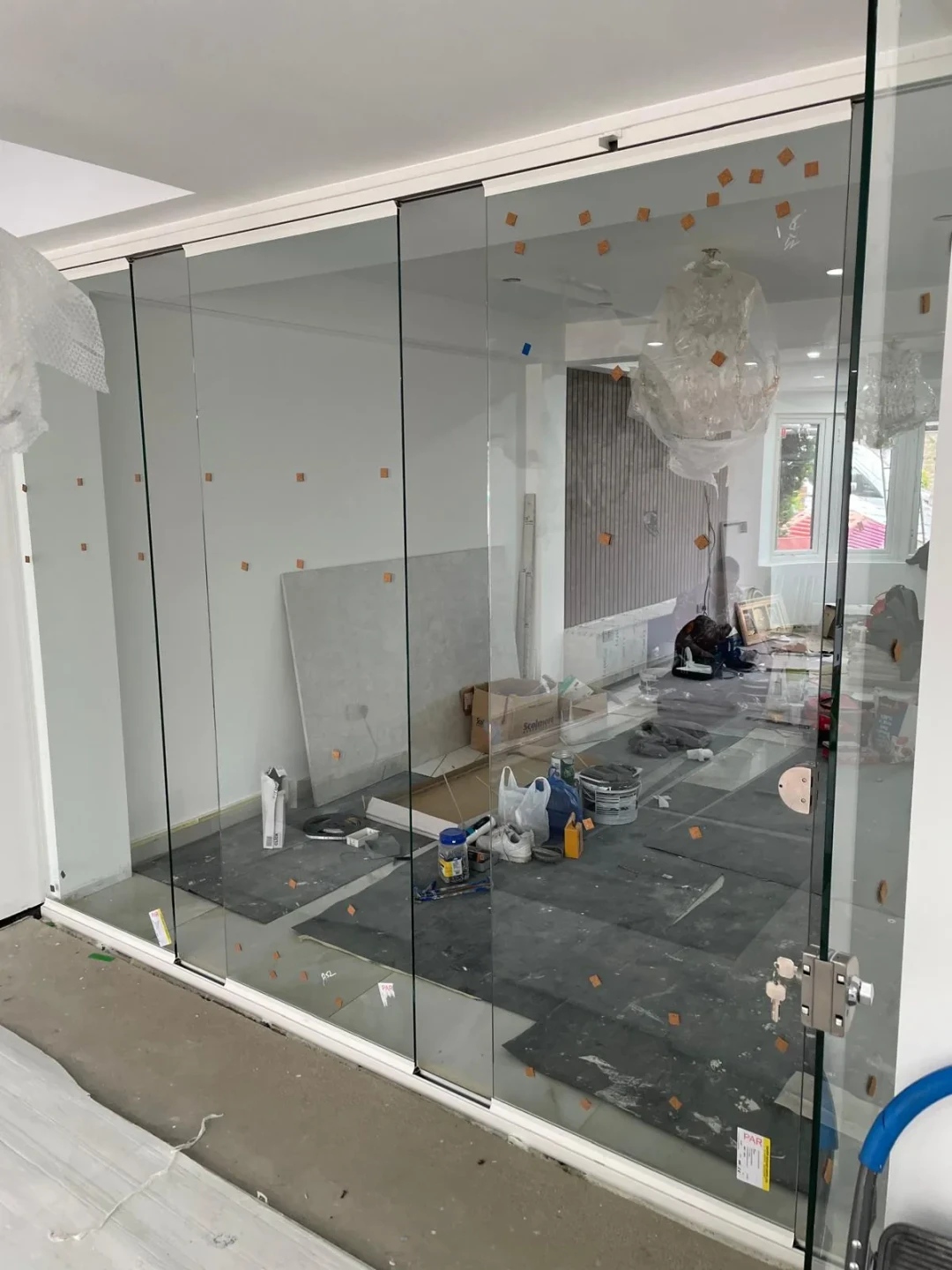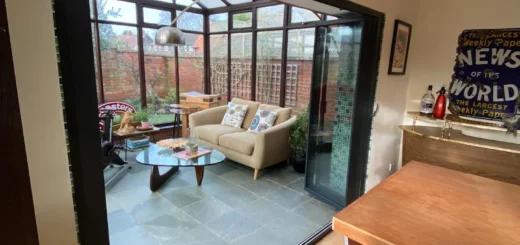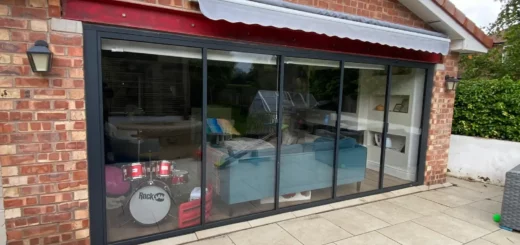Modern Interior Glass Doors: Types, Styles and Design Ideas
Table of Contents
Types of Modern Interior Glass Doors
Modern interior glass doors serve as visual highlights in contemporary British homes, blending functionality with striking design.

Frameless Glass Doors for Minimalist Spaces
Pure glass sheets mounted on discreet pivot hinges characterise frameless doors, with toughened panels often reaching floor-to-ceiling heights. These modern interior glass doors suit open-plan layouts particularly well, preserving sight lines while dividing spaces when needed. Glass thickness ranges from 8mm for smaller doors to 12mm for taller installations, providing stability without appearing bulky.
Running along nearly invisible tracks, frameless sliding systems offer the most stripped-back look possible. The glass panels glide on discrete rollers hidden within the floor channel, while slim brushed steel or matte black guides at the top maintain perfect alignment. Modern internal glass doors of this type often incorporate soft-close mechanisms, preventing the panels from slamming.
Slide and Stack Systems
Slide and turn doors (also known as slide and stack) offer different ways to part and store the glass panels. The panels move individually along a single track, then pivot and stack neatly against one wall. This design proves especially practical in spaces like home offices or dining rooms where you might want to completely open up the doorway at times.
Contemporary Bifold Options
Modern bi folding doors feature slim frames and large glass panels that concertina to one or both sides. The latest systems use specially designed roller carriages to ensure the panels fold and slide smoothly. While traditional bifolds often had chunky frames, current designs emphasise minimal visible hardware and slender profiles.
Modern Sliding Door Systems
Interior sliding doors made from glass provide clean lines and take up minimal space compared to hinged alternatives. Double-track systems allow panels to slide independently, while synchronized mechanisms enable multiple panels to move in unison. Some designs now incorporate dampened closing actions and magnetic catches that gently pull the door into its closed position.
Design Features That Define Modern Glass Doors
Glass doors have moved far beyond basic transparent panels, now incorporating innovative finishes and mechanisms that set them apart from conventional designs.

Clean Lines and Hidden Hardware
Modern interior glass doors rely on precision design to hide their working parts. Flush handles sit perfectly level with door surfaces, while spring-loaded catches stay hidden until touched. Track systems for sliding panels now fit entirely within the floor and ceiling, letting glass panels move smoothly without visible rails. Many modern internal glass doors use magnetic locks instead of traditional latches, removing the need for unsightly strike plates.
Aluminium profiles measure as little as 20mm in width, yet support substantial glass panels through advanced corner joints and reinforced sections. Some systems use structural glass with polished edges, eliminating frames completely while maintaining safety standards.
Glass Finishes and Effects
Clear glass remains popular, but new manufacturing techniques have expanded design possibilities. Low-iron glass removes the slight green tinge found in standard glass, producing crystal-clear panels. Acid-etched surfaces create smooth, translucent effects that let light through while maintaining privacy. The available range of styles often includes sandblasted patterns, from full coverage to graduated effects that fade from opaque to transparent.
Digital printing allows intricate designs to be permanently fused into glass surfaces. Abstract patterns, geometric shapes, and custom artwork become integral parts of the door rather than surface applications. These printed panels work particularly well as internal room divider doors, adding visual interest while separating spaces.
Surface Treatments and Coatings
Special coatings now protect glass surfaces without changing their appearance. Anti-fingerprint treatments repel marks and smudges, while scratch-resistant layers improve durability. Some modern interior glass doors feature self-cleaning coatings that break down dirt when exposed to UV light.
Frame Materials and Finishes
Powder-coated aluminium frames offer hundreds of RAL colours, moving beyond standard white and silver options. New textured finishes mimic materials like concrete and weathered steel, while retaining the strength of aluminium. Wood-aluminium composite frames combine timber’s warmth with metal’s durability.
Stainless steel frames suit industrial-inspired interiors, available in brushed, polished, or blackened finishes. Some modern interior glass doors use solid brass or bronze frames, which develop rich patinas over time. These premium metals work well in period properties being updated with contemporary elements.
Modern Opening Mechanisms
Recent developments in door hardware have produced new ways to open and close glass panels. Push-pivot systems let large doors swing with minimal effort, using counterbalanced mechanisms hidden in the floor. Soft-close dampers prevent slamming, while magnetic catches hold bi-fold doors perfectly aligned when closed.
Sliding systems have also improved. New roller designs run almost silently, while synchronized systems move multiple panels in perfect coordination. Some tracks now incorporate small electric motors, allowing glass doors to open automatically when approached or via smartphone controls.
These technical advances make modern internal glass doors more practical than ever. Advanced seals block sound effectively between rooms, while new glass types offer improved thermal performance. Every component works together to create doors that look simple but perform complex tasks effortlessly.
Styling Modern Interior Glass Doors in Different Spaces
Glass doors can reshape how we use our living spaces, adding light while maintaining distinct zones for different activities.

Creating Defined Zones in Open Plans
Modern interior glass doors excel at dividing spaces without blocking natural light. In kitchen-dining areas, glass kitchen doors create clear boundaries while keeping sight lines open. Frosted panels work well between food preparation areas and dining spaces, obscuring kitchen mess while maintaining a bright, airy feel.
Partial-height panels prove particularly effective in breaking up larger openings between living areas. These modern internal glass doors stop short of the ceiling, allowing air to circulate freely while still defining separate zones. Fixed side panels alongside sliding doors can extend the glazed area, making modest-sized doorways appear wider.
Acoustic Design Elements
Sound control needs careful planning in open spaces. Double-glazed panels with varied glass thicknesses reduce noise transmission between areas. Specialized interlayers between glass panes absorb sound frequencies most common in home environments. Small gaps between panels and frames now incorporate innovative brush seals that block sound without looking bulky.
Home Offices
Modern interior glass doors shine in home office setups, where privacy meets connectivity. A variety of styles suits different working patterns – pivot doors work well for occasional office access, while sliding systems save space in compact study areas. Switchable privacy glass offers instant opacity changes, perfect for video calls or focused work sessions.
Writing desks and workstations placed near glass panels benefit from natural light without glare. Strategic placement of doors can create sight lines to garden views, improving concentration and wellbeing. Glass surfaces also double as impromptu whiteboards when paired with appropriate markers.
Statement Entrance Design
Entrance halls set the tone for entire homes. Modern doors made entirely of glass create striking first impressions, especially when paired with feature lighting. Textured or patterned glass adds visual interest without compromising light flow, while tinted panels in subtle greys or bronzes complement contemporary colour schemes.
Full-height doors draw eyes upward, making corridors appear taller. Positioning modern interior glass doors at corridor ends creates appealing views through multiple spaces. Side lights – narrow glass panels flanking doors – turn simple openings into architectural features.

Multi-Room Connectivity
Open-plan living demands flexible space division. Moving glass panels allow rooms to expand for entertaining, then subdivide for everyday use. Kitchen-diners particularly benefit from this adaptability – glass doors can seal cooking odours away while maintaining visual connection to dining areas.
Careful positioning of modern doors helps create intuitive traffic flows between spaces. Glass panels sliding into wall pockets remove physical barriers completely when opened. Fixed glass screens alongside moving panels maintain light flow even when doors are closed, preventing any spaces from feeling isolated.
Glass panels near stairs or mezzanines need special attention to safety regulations. Toughened and laminated glass provides necessary protection while fitting modern aesthetics. New developments in glass strength mean even the largest panels now meet building codes without looking overtly reinforced.
Modern Interior Glass Doors for Different Design Styles
Selecting the right glass doors depends heavily on your home’s architectural character and interior style preferences.
Mid-Century Modern Spaces
Modern interior glass doors can amplify mid-century design elements through careful material selection. Slim aluminium frames in brass or copper finishes echo the metallic accents common in 1950s and 60s furniture. Walnut or teak door frames complement period wooden furniture, while maintaining clean lines essential to mid-century aesthetics.
Glass panels divided by horizontal muntins mirror classic mid-century window designs. Modern internal glass doors incorporating these details work particularly well alongside original features. Dining room sliding doors with period-appropriate handles in brushed brass or matte black complete the authentic mid-century look.
Wide glass panels suit the generous proportions typical of mid-century architecture. Sliding systems mounted on exposed metal tracks reference industrial design elements from the era. Textured glass patterns inspired by abstract art movements of the period add historical accuracy while serving practical privacy needs.
Period-Appropriate Hardware
Door handles and rails can reinforce historical connections. Cylindrical pulls in solid brass or powder-coated steel match mid-century drawer handles and light fixtures. Exposed roller mechanisms celebrate mechanical components, much like period furniture designs.
Minimalist Interiors
Modern interior glass doors reach their purest form in minimalist settings. Frameless systems eliminate visual noise, while concealed tracks and mechanisms maintain clean sight lines. Clear glass panels seem to float between spaces, supported by nearly invisible fixings.
Floor-to-ceiling panels create walls of glass that divide spaces without interrupting views. Internal doors in pure glass complement white walls and pale floors typical of minimalist schemes. Strategic use of sandblasted sections provides privacy where needed without compromising the pared-back aesthetic.
Contemporary Traditional Fusion
Modern interior glass doors can bridge old and new elements in period properties. Traditional panelled doors inspire contemporary interpretations in glass, with etched patterns echoing original wooden divisions. Crittall-style frames painted in heritage colours reference industrial windows while fitting modern requirements.
Glass panels installed within existing architraves preserve period details while updating functionality. Sliding systems hidden within original door pockets maintain historical features while adding modern convenience. Acid-etched patterns can mirror Victorian stained glass designs in contemporary ways.
Industrial Style Spaces
Raw materials and exposed mechanisms suit industrial aesthetics perfectly. Black-framed glass panels reference factory windows, while exposed steel tracks celebrate mechanical components. Modern interior glass doors with visible rollers and guide systems add authentic industrial character.
Ribbed or reeded glass provides privacy while maintaining industrial authenticity. Steel frames with visible welds and rough-finished surfaces capture workshop character. Large sliding panels mounted on exposed rails reference warehouse doors, scaled appropriately for domestic spaces.
Creative Styling Approaches for Modern Interior Glass Doors
The right accessories and surrounding elements can bring out the best qualities of glass doors while making spaces more inviting and practical.
Plants and Natural Elements
Modern interior glass doors provide ideal backdrops for indoor greenery. Tall plants like bird of paradise or fiddle leaf figs create striking silhouettes against clear glass panels. Trailing plants mounted above doorways soften hard edges while adding movement and life.
Small plant groupings near glass panels play with light and shadow throughout the day. Modern internal glass doors with frosted sections show plant shadows in interesting ways, creating ever-changing natural artwork. Planters integrated into door frames or tracks add greenery without taking up floor space.
Placing plants strategically around doors helps guide movement through spaces. Internal doors flanked by statement plants become natural focal points. Living walls installed alongside glass panels create compelling contrasts between manufactured and organic materials.
Plant Care
Glass surfaces near plants need regular cleaning to stay spotless. Anti-smudge coatings resist water marks from plant misting or humidity. Some modern interior glass doors now incorporate special UV-filtering layers that protect plants from excessive sun exposure.
Lighting and Glass Interplay
Lighting placement can hugely change how modern interior glass doors look and perform. Wall lights mounted beside glass panels create interesting reflections and shadows. Strip lighting concealed in door frames outlines glass panels with subtle illumination.
Pendant lights suspended near glass doors cast intriguing patterns across surfaces. Directional spotlights aimed at textured or patterned glass create dynamic visual effects. Modern interior glass doors with switchable privacy glass take on different characters as lighting conditions change.
Textile and Surface Layering
Fabrics near glass surfaces add warmth and acoustic benefits. Curtains mounted on ceiling tracks can provide optional privacy for modern interior glass doors while adding visual softness. Natural materials like linen or wool absorb sound without looking heavy.
Rugs placed near glass doors help define separate zones while adding comfort underfoot. Different floor finishes meeting at door thresholds create natural boundaries between spaces. Wall textures contrasting with smooth glass surfaces add visual depth and interest.
Colour and Pattern Play
Paint colours chosen for walls around glass doors influence how spaces feel. Dark walls make glass panels appear to float, while pale colours build brightness. Modern interior glass doors featuring coloured glass sections add subtle tints to natural light.
Geometric patterns in surrounding tiles or wallcoverings complement door designs. Metallic finishes on nearby surfaces create interesting reflections in glass panels. Abstract designs applied to glass surfaces themselves become artwork when light shines through.
Furniture Placement and Space Planning
Arranging furniture near glass doors requires careful thought about traffic flow. Seating oriented toward glass panels takes advantage of views between spaces. Low-profile pieces preserve sight lines through modern interior glass doors while providing practical function.
Storage units with reflective surfaces multiply light coming through glass panels. Mirrors positioned strategically near doors increase perceived space and brightness. Furniture with glass elements creates visual harmony with door materials.
Art and Decorative Elements
Artwork hung near glass doors needs careful positioning to avoid unwanted reflections. Sculptural pieces viewed through glass panels create layered visual interest. Three-dimensional wall art adds depth to spaces divided by modern interior glass doors.
Free-standing sculptures placed near glass panels cast interesting shadows as sun moves. Wall-mounted objects in metal or ceramic complement door hardware finishes. Collections displayed behind glass doors become curated exhibits within living spaces.
About SunSeeker Doors
With over 20 years of experience, SunSeeker Doors remains at the forefront of door design with our quality-tested patio doors and related products, including the bespoke UltraSlim aluminium slide and pivot door system, Frameless Glass Doors, and Slimline Sliding Glass Doors. All of our doors are suitable for both internal and external use.
To request a free quotation, please use our online form. You may also contact 01582 492730, or email info@sunseekerdoors.co.uk if you have any questions.




